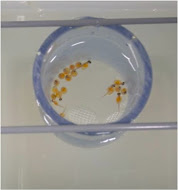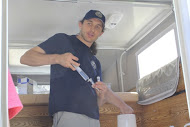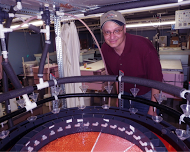
|
|
Larval fish experiments. Conducting trials at early life stages is difficult, but this is typically when fish are most sensitive to pollution. |
The majority of toxicological research considered during the derivation of water quality standards is conducted under standardized laboratory conditions and design. Standardized trails, though repeatable across laboratories, often lack environmental realism. The overuse of lab cultured or mail-order species leaves rare and sensitive species underrepresented. Consideration of only one stressor on one species ignores the complexities of nature, ignores synergism between toxicants and ignores ecosystem functions and community structure on higher levels of biological organization. Standardized durations adopted by regulatory agencies are arbitrary and rarely include full life cycles, multi-generational population dynamics or sensitive life stages. While the CPW Aquatic Toxicology Laboratory adopts traditional toxicology methodologies when appropriate, the majority of experiments are tailored to the question being asked and the Colorado organisms or ecosystem being considered. Laboratory facilities were designed to be readily modifiable to accommodate development of new experimental techniques that add environmental realism. Focus on only mortality during toxicity experiments can lead to underprotective standards. It is important to also examine sublethal effects. Because of this, CPW researchers are constantly expanding the endpoints measured on all levels of biological organization. Laboratory staff members address questions with a suite of laboratory experiments, field experiments and biomonitoring. This is needed because site-specific questions require researchers to consider the complex effects of toxicant mixtures interacting within a diverse and multi-faceted natural ecosystem, which often differs from a single species responding to a single toxicant in a beaker.
Facilities
Mount and Brungs Diluter – now obsolete, this style of diluter was used in many of the experiments at the CPW Aquatic Toxicology Laboratory in the 1980s and 1990s.
Laboratory facilities at the Fort Collins office host diverse equipment for conducting toxicity trials, culturing rare species, analyzing water samples and examining physiological and behavioral responses to toxicants. To accommodate the diverse habitat needs of fish, insects, algae and aquatic communities, researchers design exposure cages and life support systems to simulate environmental conditions when field experiments are not possible. The facility has the ability to replicate the physical and chemical qualities of most locations in Colorado. The laboratory utilizes an onsitehardwater well, dechlorinated municipal tap water and reverse osmosis equipment for toxicology tests. By mixing these waters, toxicity tests can be conducted over a wide range of water quality conditions.
Various toxicant diluters, pumps, temperature controllers and aerators are available to cross toxicant concentrations with other environmental stressors in continuous flow through conditions. The lab's scientific fabrication abilities have allowed diluters, treatment cages and infrastructure to be made of glass, polytetrafluoroethylene (PTFE) and stainless steel when working with organic toxicants (e.g. pesticides and herbicides) and plastic when working with metals.
Because CPW is concerned with rare and sensitive species that cannot be cultured, the laboratory does significant work with field collected species. This has required significant infrastructure and method development to culture food sources that approximate diets observed in nature. Because fish depend on insects, algae, meiofauna, fungus, bacteria and other microbes, the labs staff members have diverse taxonomic skillsets and collaborate with specialists.
Heptagenid mayflies consuming periphyton

|
|
One of the CPW Aquatic Toxicology Laboratory's mobile labs. In this photo toxicology lab staff drove two high performance liquid chromatographs to Arizona to provide on-site analysis of Rotenone during invasive species removal on the Virgin River. |
The CPW Aquatic Toxicology Laboratory is lucky to host the analytical branch of
Colorado River Watch with whom it shares knowledge, labor and resources. The lab's analytical capabilities are not limited to: photospectroscopy, atomic absorption spectroscopy, inductively coupled plasma emission spectroscopy, gas chromatography, high performance liquid chromatography, pulse amplitude modulated fluorometry and numerous other instruments common to water quality laboratories. Many of these instruments have been modified for use in the mobile laboratories during field experiments, biomonitoring, fish kill response and stream reclamations.
CPW's network of hatcheries and fish managers allows diverse species and age classes to be available for experiments. Ability to spawn and rear larval fish has allowed trials to be done at sensitive life stages. CPW's Toxicology Laboratory is one of the only labs that is able to rear
Colorado mountain whitefish and one of few lucky enough to work with rare species like mottled sculpin, longnose dace, flathead chub and many strains of
cutthroat trout. Use of naturally colonized communities of algae and insects has improved the environmental realism of toxicity trials with macroinvertebrates. The lab is also one of only a few facilities conducting trials on nearly microscopic first instar aquatic insects, only 24 hours after hatching from an egg. Though toxicology staff members conduct field experiments and mobile laboratory work throughout the state, the toxicology laboratory is located in Fort Collins, which allows for collaboration with experts at numerous universities and agencies on the federal, state and local level.
Heavy Metal Pollution
The Colorado Water Quality Control Commission estimates that metals adversely affect over 2,080 km of streams in Colorado. Colorado Parks and Wildlife has studied the effects of metals on aquatic organisms for over 35 years. Early investigations focused on the effects of metals on salmonids and non-game species, which led to the development of numeric hardness-based metal standards for the protection of aquatic life in Colorado. Colorado was the first US state to implement numeric metal standards.
In the years that followed, trials expanded to include direct effects on macroinvertebrates. Building on these findings, the importance of species interactions and community structure became apparent. CPW conducted and collaborated on many field and laboratory based projects including communities of fish, insects and algae in heavy metal research. The lab now pushes for improved models of toxicity for interactions of heavy metals and other stressors. Researchers continue to adopt and pioneer new sublethal endpoints affected by heavy metals.
Organic Toxicants
As Colorado's economy shifted from mining to industry and as the population continues to grow, the laboratory has been investing in expanding its abilities to measure and study emerging toxicants in Colorado. This includes pharmaceuticals, pesticides, herbicides, hygienic products and other toxicants.
Temperature and Water Quality Studies

|
| Colorado State University student Alex Townsend conducts Critical Thermal Maxima assessments on mountain whitefish reared in the laboratory. In this and similar studies, researchers found that the thermal tolerance of most species of trout in Colorado is reduced after exposure to sublethal levels of copper. |
With increasing urbanization and anthropogenic climate changes, temperature and flows in Colorado surface water are changing. The CPW Aquatic Toxicology Laboratory has expanded its ability to prescribe various temperature regimes with and without the presence of non-temperature stresses. These studies include examining optimal or suitable temperatures for sensitive species and examining thermal tolerance as a sublethal endpoint during toxicant trials.
Great Plains fishes in river basins of eastern Colorado have been declining and many are now listed as threatened or endangered, including the common shiner, brassy minnow, Arkansas darter, stonecat and others. Several factors have been identified as contributing to declines of plains fishes, including altered flow regimes through diversions and impoundments, predation by non-native fish, channelization and simplification of riverbeds, and general loss of habitat. Reduced water quality from increased urbanization and intense agricultural use likely contribute to population declines; however, the impacts of chemical stressors have not been well studied. CPW toxicology researchers are investigating the impacts of urban and agricultural stressors, not limited to ammonia, nutrients, temperature, turbidity and endocrine disrupting chemicals, on native plains fish species.
 |
Justin Pomeranz assessing aquatic insect emergence. This was part of a CPW and Colorado State University project at a restoration site near Leadville Colorado. Aquatic insect nymphs build body mass as nymphs and then emerge as adults. This provides huge energy subsidies for wildlife but might also expose terrestrial wildlife to aqueous toxicants. |
Research
Examples of research:
Toxicity of copper (Cu), cadmium (Cd) and zinc (Zn) to Colorado native aquatic species.
Exposure of Cu, Cd and Zn to fish egg and sperm during mating and hardening.
Effects of acute Zn and Cu exposure to first instar Baetis sp. and comparisons to larger organisms.
Effects of heavy metals on community assemblages of benthic invertebrates.
Direct and indirect effects of iron (Fe) on aquatic insect communities and algal communities.
Synergistic effects of Fe, Cu and Zn pollution on algal and insect populations.
Reduced thermal tolerance of Colorado mountain whitefish, rainbow, brook and cutthroat trout species after sublethal acute exposure to Cu and Zn.
Differences in metal toxicity in various static and oscillating temperature regimes.
Numerous field studies examining impacts of heavy metals on fish and insect populations and restoration efforts.
Direct effects of Fe on brown trout, mountain whitefish, Planaria, Hexagenia, Lumbriculus, boreal toad tadpoles and macroinvertebrate communities – recalculation of Fe standards.
Effects of Fe on colonization, drift and survival of aquatic insect communities.
Effect of agitation and temperature on the hatch success, hatch timing and fat levels of mountain whitefish eggs and larva.
Evaluation of hatch success for rainbow trout spawned and hardened in various temperature regimes.
Effects of sub-lethal acute metals exposures on the critical thermal maxima and critical dissolved oxygen minima of mountain whitefish, cutthroat trout and brook trout at numerous age classes.
Indirect effects of Fe on macroinvertebrates and periphyton communities at levels below the current state standard.
Colonization rate and photosynthetic efficiency of periphytic algae species in low levels of Cu, Zn and herbicides.
Subcellular fractionation techniques for organisms of small body size (0.00425g-0.2g wet)
Relative importance of dietary and aqueous exposure of Zn to grazing mayflies.
Survey of subcellular accumulation of metals in numerous feeding guilds and taxonomic groups of aquatic insects.
Research and development for improved ability to assess algal health and community composition.
Research and development for improved ability to assess organic toxicants and characterize toxicity.
Publications
For a list of annual reports summarizing toxicity research please see the Water Pollution Studies section of the
Publications and Reports page.
Agency Section & Personnel:
Colorado Parks & Wildlife - Aquatic Research Section
Aquatic Toxicology Research Laboratory
317 W. Prospect Road, Fort Collins, CO 80526 USA
 |
Pete Cadmus
Aquatic Toxicology Research Scientist
Pete.Cadmus@state.co.us
970-472-4332
|
| Pete Cadmus filtering water samples in the mobile laboratory. During this experiment, fish eggs and sperm were exposed to heavy metals during spawning and egg hardening. |
 | Steve Brinkman
Contributing Scientist
Steve.brinkman@state.co.us |
| Steve Brinkman shows off the temperature preference chamber constructed by him and lab technician Jordan Anderson. Although Steve has retired from his position as the state aquatic toxicologist, he works for the lab part time, often pro bono, running toxicity trials, fixing analytical equipment, consulting on policy issues and writing his backlog of manuscripts. |

